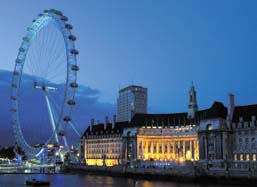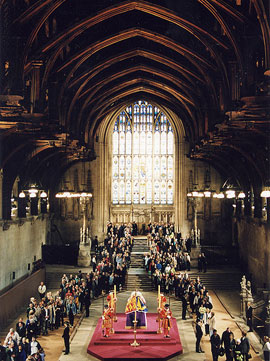SPOTLIGHT: 26 June, 2007
Westminster Hall
"What a feast to set before the King"by Burlington Bertie.
he great Royal feasts of medieval courts and Merry England have passed into legend. But in fact we have precious little archive material to illuminate these culinary occasions other than a few Royal Household purchasing accounts, some exhortations to prune Royal expenditure on banqueting, a treatise or two on dining etiquette in the Royal presence, and a few 13th and 14th century illuminated manuscripts portraying a princely repast. To catch a feel for such royal feasting we can visit the now deserted and echoing Great Hall of Westminster during Parliament's summer recess, or visit Hampton Court Palace to see Henry VIII's great banqueting hall there and the restored kitchens that fed King and courtiers in such state.
Palace of Westminster, SW1A 0AA.
Access 9.15am-4.30pm. 31 July - 3 October, 2007. Closed Sundays, Bank Holidays. Wheelchair accessible, (except for Big Ben), guided tours lasting 75 minutes take place throughout the day during the summer months.
Tickets £12, (Concessions). Online Booking, (recommended); Box Office: 0870 906 3773 or at entrance. Tickets are date-timed. Check website for instructions.
London Transport: Nearest Tube. Westminster, (Jubilee/Circle & District Lines). Riverboat. Westminster Millenium Pier.
 Burlington Bertie's Accommodation Choice: Burlington Bertie's Accommodation Choice:
 Westminster Bridge Road, SE1 2PB.
This is 5-star comfort in elegantly opulent architectural splendour with an unrivalled Thames-side view overlooking Westminster Bridge, Big Ben and the Houses of Parliament opposite. Enjoy air-conditioned en-suite rooms and make sure you book a room with Thames view. Relax after sightseeing in the hotel's indoor pool while your partner enjoys a treatment in the spa, before making the pleasant five minute riverside walk to the Skylon Restaurant at the Royal Festival Hall. Boat trips upriver to the 15th Hampton Court Palace Summer Festival or downriver to the 11th Greenwich and Docklands Festival, (see Out & About in London June for details) start from the Millennium Pier just opposite the hotel.

Find Another Hotel
|
| Want to receive our new Out & About Newsletter by email? Just type your email address below and click the submit button.
| |
 Lying in State, Queen Elizabeth the Queen Mother.2002. Photo Deryc Sands. Copyright Parliament.
Royal banqueting was first transformed from a loutish Saxon debauchery into an instrument of royal policy and Norman diplomacy by William the Conqueror who built the first Great Hall at Westminster next to the Abbey where he had been crowned on Christmas Day in 1066. It was to be enlarged by his son William Rufus. It was rebuilt and enlarged yet again in Gothic splendour with the hammer beam roof that we admire so much today by Plantaganet King Richard II nearly 300 years later. King Richard had commissioned Henry Yevele, England's great master mason of the Gothic era, to completely reconstruct the Norman hall of William Rufus in the new architectural style imported from France, as had been the Norman style with the arrival of William the Conqueror. Yevele was already rebuilding Westminster Abbey next door, demolishing the old Norman nave to construct the high Gothic vaulted inspiration we see today, and similarly reconstructing the nave of Canterbury Cathedral while also supervising the construction of that city's defensive walls and West Gate. He had designed the tomb-chest of Richard's grandfather and predecessor King Edward III and was to survive Richard, his royal benefactor and patron, to design his tomb-chest as well. They stand end to end at the side of the chancel in Westminster Abbey.
It was during Richard's turbulent reign, (1377-1399), that the great banqueting era of the medieval royal court reached its unlikely apogee. It was an era of 'dung and diamonds' at the Palace of Westminster with its spanking Great Hall, now the largest and grandest in Europe. Courtiers strutted in cloth of gold weighted with precious stones, the cut of their sleeves lengthened to brush the ground, the points of their shoes so long that they had to be caught up by golden chains tied to the knee or even waist. When not dressing up like popinjays and entertaining themselves with fancy dress carnival parades and lustful pursuits frowned upon by the Church, the courtiers were feasting at the King's expense.
A motley assortment of 10,000 sybaritic dandies, concubines, attendants and dependents were fed daily by the Royal kitchens within the King's royal enclave at Westminster. Records show that 28 oxen, 300 sheep and uncounted fowl were slaughtered daily to feed the ever-turning spits manned by an army of 300 in the kitchens, which must have been like a scene from Dante's Inferno. Such a drain on the feudal economy was exacerbated by the ravages of the bubonic plague (1347- 1351), which killed one-third of the European population and strained the feudal system of serfdom to an explosive breaking point in the 1381 Peasants' Revolt. The King's carnival could not last. Richard was finally deposed and mysteriously disposed of by usurper Henry IV and his court of useless glitterati dispersed like chaff in the wind.
The Great Hall of Westminster remained in use thereafter as the traditional venue for coronation banquets until the 19th century when William IV cancelled it as an unneccessary expense. But its vast interior was to become famous as the site of the great treason trials of the day including that of Thomas More, the Gunpowder Plot conspirators, King Charles I and Warren Hastings.
Since the death of Gladstone in 1898 Westminster Hall has been the sombre setting for lyings-in-state of sovereigns and great political leaders. I have witnessed these solemn rites of national mourning for King George VI in 1952, his mother Queen Mary the following year, Sir Winston Churchill in 1965 and more recently in 2002, for Queen Elizabeth the Queen Mother.
Related Links
The Houses of Parliament
Hampton Court Palace
|
© 2007 offtolondon.com All rights reserved.
Contact Us |
|
